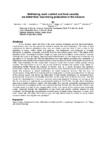Use este identificador para citar ou linkar para este item:
http://www.alice.cnptia.embrapa.br/alice/handle/doc/660608Registro completo de metadados
| Campo DC | Valor | Idioma |
|---|---|---|
| dc.contributor.author | BARBOSA, T. M. F. | pt_BR |
| dc.contributor.author | TOURRAND, J. F. | pt_BR |
| dc.contributor.author | NAHUM, B. S. | pt_BR |
| dc.contributor.author | VEIGA, J. B. da | pt_BR |
| dc.contributor.author | QUANZ, D. | pt_BR |
| dc.contributor.author | SIST, P. | pt_BR |
| dc.contributor.author | SCOPEL, E. | pt_BR |
| dc.contributor.author | HOMEM, V. S. F. | pt_BR |
| dc.date.accessioned | 2011-04-10T11:11:11Z | pt_BR |
| dc.date.accessioned | 2011-04-10T11:11:11Z | pt_BR |
| dc.date.available | 2011-04-10T11:11:11Z | pt_BR |
| dc.date.available | 2011-04-10T11:11:11Z | pt_BR |
| dc.date.created | 2010-03-10 | pt_BR |
| dc.date.issued | 2008 | pt_BR |
| dc.identifier.citation | In: WORLD CONGRESS OF RURAL SOCIOLOGY, 12., 2008, Goyang. Envisioning prosperous rural futures in a globalizing world. [S.l.]: IRSA, 2008. | pt_BR |
| dc.identifier.uri | http://www.alice.cnptia.embrapa.br/alice/handle/doc/660608 | pt_BR |
| dc.description | In the Amazon, slash and burn is the most common technique used by American-Indians, small farmers and even big ranches to transform forests into rural landscapes. The basis of food subsistence for diverse populations (rice, corn and bean), slash and burn is also a must for the plantation of cocoa, coffee, palms and pastures. The Amazonian rural landscape is currently dominated by pastures, occupying around 80 % of the deforested surface. Even if the nature of the plantation varies according to location, height, soil type and local traditions, slash and burn remains relatively the same in all regions. Agro-ecological intensification and the integration of livestock and agriculture is 2-3 decades old. Different alternatives have been tested, particularly the introduction of leguminous (covering the land or forming trees) to improve the soil and to build a bank of proteins for cattle. New techniques for the recuperation of pasture lands have become widely popular among ranches. The introduction of one or two annual plantations between two pasture areas allows reestablishing fertility through the injection of nitrates and, as a result, increases the pasture?s productivity. However, being relatively high-cost because of its demand in terms of mechanization and inputs, this technique is almost unaffordable for small Amazonian farmers... | pt_BR |
| dc.language.iso | eng | eng |
| dc.rights | openAccess | eng |
| dc.subject | Agroecologia | pt_BR |
| dc.title | Well-being, work comfort and food security are better than maximizing production in the Amazon. | pt_BR |
| dc.type | Artigo em anais e proceedings | pt_BR |
| dc.date.updated | 2013-04-19T11:11:11Z | pt_BR |
| dc.subject.nalthesaurus | Amazonia | pt_BR |
| riaa.ainfo.id | 660608 | pt_BR |
| riaa.ainfo.lastupdate | 2013-04-19 | pt_BR |
| dc.contributor.institution | T. M. F. BARBOSA, UNB | pt_BR |
| dc.contributor.institution | JEAN-FRANÇOIS TOURRAND, UNB/CIRAD | eng |
| dc.contributor.institution | BENJAMIM DE SOUZA NAHUM, CPATU | eng |
| dc.contributor.institution | JONAS BASTOS DA VEIGA, CPATU | eng |
| dc.contributor.institution | DARCISIO QUANZ, CPATU | eng |
| dc.contributor.institution | PLINIO SIST, CIRAD/EMBRAPA | eng |
| dc.contributor.institution | E. SCOPEL, CIRAD/EMBRAPA | eng |
| dc.contributor.institution | V. S. F. HOMEM, MINISTERIO DA AGRICULTURA. | eng |
| Aparece nas coleções: | Artigo em anais de congresso (CPATU)  | |
Arquivos associados a este item:
| Arquivo | Descrição | Tamanho | Formato | |
|---|---|---|---|---|
| SP6230.pdf | 270,8 kB | Adobe PDF |  Visualizar/Abrir |









